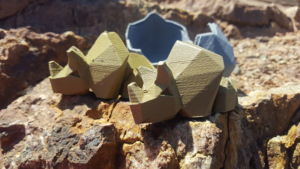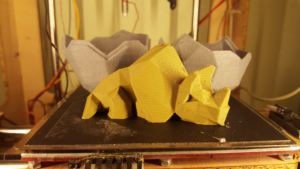We have plenty of business, material, and 3D printer news to share with you in today’s 3D Printing News Briefs. 3D printing led to increased savings for GM over the last two years, which is now increasing its use of the technology as a result. ExOne is saying goodbye to one CEO and hello to another, while Polymaker announces a global distribution arrangement with Nexeo Solutions and CollPlant receives R&D project approval in Israel. The US Patent and Trademark Office will be hosting its annual Additive Manufacturing Partnership Meeting this week, and RP Platform has announced a rebrand and a new AI software platform. Finally, the UK’s National Centre for Additive Manufacturing has decided to add Digital Metal’s binder jetting technology to its portfolio.
GM Increasing Use of 3D Printing at Plants

Zane Meike, AM lead at GM’s Lansing Delta Township assembly plant, holds a common 3D printed tool used to align engine and transmission vehicle identification numbers. [Photo: Michael Wayland]
According to Dan Grieshaber, the Director of Global Manufacturing Integration for General Motors (GM), most of the company’s factories have 3D printers, which are used to build accessories and tools for workers. A $35,000 3D printer at GM’s Lansing Delta Township assembly plant has actually helped save the company over $300,000 over two years: it’s used to make multiple items, such as part hangers, socket covers, and ergonomic and safety tools. A common tool used to align engine and transmission vehicle identification numbers cost $3,000 to buy from a third party, but is less than $3 to 3D print at the factory. Realizing that these kinds of savings can add up quickly, GM is increasing the use of 3D printing – part of its new Manufacturing 4.0 processes – at its plants in order to help streamline operations.
“We’re quickly evolving, creating real value for the plant. This will become, as we progress, our footprint. We’ll have this in every one of our sites,” Grieshaber said.
Grieshaber also said that GM is working to standardize 3D printing, as well as share best practices across all of its global plants.
ExOne Welcomes New CEO
 The ExOne Company, which provides 3D printers and 3D printed products, materials, and services to its industrial customers around the world, has announced that its CEO, James L. McCarley, is departing the company, effective immediately, to pursue other interests and opportunities; he will be assisting the company in transitioning his responsibilities to the new CEO. ExOne’s Board of Directors has also announced who the new CEO will be – S. Kent Rockwell, the company’s Executive Chairman, who has served in the position in previous years. Rockwell’s new title is effective immediately.
The ExOne Company, which provides 3D printers and 3D printed products, materials, and services to its industrial customers around the world, has announced that its CEO, James L. McCarley, is departing the company, effective immediately, to pursue other interests and opportunities; he will be assisting the company in transitioning his responsibilities to the new CEO. ExOne’s Board of Directors has also announced who the new CEO will be – S. Kent Rockwell, the company’s Executive Chairman, who has served in the position in previous years. Rockwell’s new title is effective immediately.
“On behalf of our Board and management team, I would like to thank Jim for his efforts and wish him all the best in his future endeavors,” said Rockwell.
Polymaker Makes Distribution Arrangement with Nexeo Solutions
 Shanghai-based 3D printing material producer Polymaker has entered an arrangement with chemicals and plastics distributor Nexeo Solutions, Inc., also based in Shanghai. Nexeo will be a global distributor for three new materials in the Polymaker Industrial line, but plans to introduce more of its materials over the rest of the year. C515 is an advanced polycarbonate (PC) filament that has excellent toughness and a low warping effect, while C515FR is a flame retardant PC with high impact resistance. SU301 is a polyvinyl alcohol (PVA)-based polymer that’s water soluble and was developed as a support material for FFF 3D printers.
Shanghai-based 3D printing material producer Polymaker has entered an arrangement with chemicals and plastics distributor Nexeo Solutions, Inc., also based in Shanghai. Nexeo will be a global distributor for three new materials in the Polymaker Industrial line, but plans to introduce more of its materials over the rest of the year. C515 is an advanced polycarbonate (PC) filament that has excellent toughness and a low warping effect, while C515FR is a flame retardant PC with high impact resistance. SU301 is a polyvinyl alcohol (PVA)-based polymer that’s water soluble and was developed as a support material for FFF 3D printers.
Paul Tayler, the Vice President of EMEA at Nexeo Solutions, said, “Expanding our portfolio to include industrial grade filaments from Polymaker Industrial gives our customers access to a wider range of filaments that solve new 3D printing challenges and meet the demands of manufacturers. Industrial customers benefit from Nexeo Solutions’ access to world leading plastic producers coupled with additive manufacturing technical expertise.”
CollPlant Receives R&D Project Approval
 Two years ago, regenerative medicine company CollPlant received funding from Israel’s Ministry of Economy for its research in developing collagen-based bioinks for 3D printing tissues and organs. CollPlant, which uses its proprietary plant-based rhCollagen (recombinant human collagen) technology for tissue repair products, has now announced that the Israel Innovation Authority (IIA) has approved a grant to finance the continued development of its rhCollagen-based formulations intended for use as bioinks. Terms of the grant require CollPlant to pay royalties to the IIA on future sales of any technology that’s developed with the use of the funding, up to the full grant amount. The total project budget is roughly $1.2 million (NIS 4.2 million), and the IIA will finance 30%, subject to certain conditions.
Two years ago, regenerative medicine company CollPlant received funding from Israel’s Ministry of Economy for its research in developing collagen-based bioinks for 3D printing tissues and organs. CollPlant, which uses its proprietary plant-based rhCollagen (recombinant human collagen) technology for tissue repair products, has now announced that the Israel Innovation Authority (IIA) has approved a grant to finance the continued development of its rhCollagen-based formulations intended for use as bioinks. Terms of the grant require CollPlant to pay royalties to the IIA on future sales of any technology that’s developed with the use of the funding, up to the full grant amount. The total project budget is roughly $1.2 million (NIS 4.2 million), and the IIA will finance 30%, subject to certain conditions.
“In addition to providing immediate non-dilutive funding, this grant from the Israel Innovation Authority represents an important validation of our BioInk technology and its market potential. With the recent opening of our new cGMP production facility in Rehovot, Israel, we are well positioned to meet growing demand for our BioInk and tissue repair products. We are grateful to the IIA for this recognition,” said CollPlant CEO Yehiel Tal.
Additive Manufacturing Partnership Meeting Hosted by US Patent and Trademark Office
 For the last several years, the US Patent and Trademark Office (USPTO) has been hosting the Additive Manufacturing Partnership Meeting, and this year’s meeting takes place tomorrow, June 27th, from 1 to 5 PM at the USPTO headquarters inside the Madison Building in Alexandria, Virginia. The USPTO will be seeking opinions from various participants at the informal meeting, which is really a forum for individual 3D printing users and the USPTO to share ideas, insights, and personal experiences.
For the last several years, the US Patent and Trademark Office (USPTO) has been hosting the Additive Manufacturing Partnership Meeting, and this year’s meeting takes place tomorrow, June 27th, from 1 to 5 PM at the USPTO headquarters inside the Madison Building in Alexandria, Virginia. The USPTO will be seeking opinions from various participants at the informal meeting, which is really a forum for individual 3D printing users and the USPTO to share ideas, insights, and personal experiences.
“We value our customers and the feedback provided from individual participants is important in our efforts to continuously improve the quality of our products and services,” the USPTO meeting site reads. “Your willing participation in this informal process is helpful in providing us with new insights and perspectives.”
Scheduled speakers at this year’s meeting are coming from CIMP-3D, HRL, Kansas State University, Lawrence Livermore Laboratories, and the NextManufacturing Center, and an RSVP is required to attend the AM Partnership Meeting.
RP Platform Launches New AI Software and Rebrand
 London-based RP Platform, which provides customizable workflow automation software for industrial 3D printing, is launching a new software platform, which will use AI for the first time to automate 3D printing production. With customers in over 30 countries, the company is one of the top automation software providers for industrial 3D printing. In addition to its software launch, RP Platform has also announced that, as it continues to expand its software capabilities to target AM end part production, it is rebranding, and has changed its name to AMFG.
London-based RP Platform, which provides customizable workflow automation software for industrial 3D printing, is launching a new software platform, which will use AI for the first time to automate 3D printing production. With customers in over 30 countries, the company is one of the top automation software providers for industrial 3D printing. In addition to its software launch, RP Platform has also announced that, as it continues to expand its software capabilities to target AM end part production, it is rebranding, and has changed its name to AMFG.
“We want to help companies make their 3D printing processes much smoother so that they can produce more parts with greater visibility and less effort. And we have more exciting releases to our software over the coming months that will further enhance our production automation capabilities,” said Keyvan Karimi, the CEO of AMFG.
“Ultimately, we’re creating a truly autonomous manufacturing process for industrial 3D printing. For us, this means taking manufacturing to a new era of production. The launch of our new software, as well as our company rebrand, fully reflects this vision going forward.”
NCAM Installing a Digital Metal 3D Printer
 The National Centre for Additive Manufacturing (NCAM) in the UK, headquartered at the Manufacturing Technology Centre (MTC) in Coventry, has decided to add the unique binder jetting technology developed by Digital Metal to its large range of advanced manufacturing equipment, and will soon be installing one of its high-precision metal 3D printers – which are not available anywhere else in the UK. The 3D printer will be available for use by NCAM’s member companies, and other organizations, who are interested in testing the capabilities of Digital Metal’s proprietary binder jetting technology.
The National Centre for Additive Manufacturing (NCAM) in the UK, headquartered at the Manufacturing Technology Centre (MTC) in Coventry, has decided to add the unique binder jetting technology developed by Digital Metal to its large range of advanced manufacturing equipment, and will soon be installing one of its high-precision metal 3D printers – which are not available anywhere else in the UK. The 3D printer will be available for use by NCAM’s member companies, and other organizations, who are interested in testing the capabilities of Digital Metal’s proprietary binder jetting technology.
Dr. David Brackett, AM Technology Manager at the NCAM, explained, “The Digital Metal binder jetting technology falls into the category of ‘bind-and-sinter AM’, where a multi-stage process chain incorporating sintering is required to achieve full density. It’s a very fast technology that can create complicated and highly detailed designs, and there is potential for wider material choice than with AM processes that use melting. We are delighted to be able to offer this to the companies we work with.”
The Digital Metal 3D printer will be operational later this summer, and NCAM personnel are already training with it to ensure they can operate it efficiently and safely.
Discuss all of these stories, and other 3D printing topics, at 3DPrintBoard.com or share your thoughts in the Facebook comments below.


















